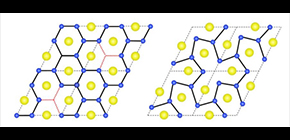
New material to efficiently convert heat to electricity, YbSiGe, developed
Will be applied to energy harvesting and improving of fuel efficiency of motor vehicles
A group of researchers led by Associate Professor KUROSAKI Ken at the Graduate School of Engineering, Osaka University, in cooperation with Hitachi Ltd., discovered silicon ytterbium germanium (YbSiGe), a new material that exhibits a higher thermoelectric power factor in the temperature range from room temperature to around 100℃.
In 2018, Osaka University and Hitachi Ltd. developed ytterbium silicide [YbSi 2 ], a new TE material with an improved thermoelectric (TE) power factor at room temperature.
In the current study, the group attempted to improve the power factor of YbSi 2 by substituting Silicon (Si) with Germanium (Ge), significantly optimizing the power factor of YbSiGe when the Si/Ge ratio in YbSiGe was 1:2. This will lead to the practical use of TE technology to effectively utilize energy by changing low-grade energy abundant in the environment into high-grade energy.
They found that a composite YbSiGe demonstrated the maximum absolute value of Seebeck coefficient ( S ), 55μV K -1 , although it showed high electrical conductivity ( σ ) attributed to the intermediate valence behavior of Yb.
Many new TE conversion materials have been developed in the range of 300℃ or higher as a range of applications of TE power generators. (The absolute value of S of YbSiGe and other ordinary metal materials is usually around 10μVK -1 .) However, no materials other than Bismuth telluride (Bi 2 Te 3 ) have been discovered in the low-temperature range, from room temperature to 100℃.
In the low-temperature range from room temperature to 100℃, YbSiGe showed better power factor ( S 2 σ ), which determines the output power of power generation devices, than that of Bi 2 Te 3 .
TE technology has been used for a powering atomic batteries mounted on planetary exploration spacecraft as a highly reliable means of maintenance-free, small, and lightweight powering.
In this study, using abundant low toxic silicon as a base material, the thermoelectric power factor ( S 2 σ ) was significantly improved at near-ambient temperature. This will accelerate the practical use of TE technology, technology for generating electrical energy from normally unused energy sources available in the surrounding environment. Specifically, TE technology can be used for energy harvesting, a process of generating energy from naturally-occurring energy sources, and waste heat recovery systems for improving fuel efficiency of cars.
Abstract
Metal silicide-based thermoelectric (TE) materials have attracted attention owing to low toxicity and high chemical stability. Here, we demonstrate that ytterbium silicon-germanium, Yb(Si 1− x Ge x ) 2−δ , shows a large Seebeck coefficient (S) accompanied by metal-like high electrical conductivity (σ) attributed to the intermediate valence behavior of Yb (Yb 2+ /Yb 3+ ). We revealed that x = 0.5, i.e., YbSiGe, is the best composition with the highest power factor (S 2 σ) of 3.6 mW m −1 K −2 at room temperature, which is comparable to those of conventional TE materials, such as Bi 2 Te 3 .

Figure 1

Figure 2
Table 1

This research was funded by part of a grant for the project "Scientific Innovation for Energy Harvesting Technology," under the Strategic Basic Research Programs (CREST) of the Japan Science and Technology Agency (JST).
The article, “High Thermoelectric Power Factor of Ytterbium Silicon-Germanium” was published in Physical Review Materials at DOI: https://doi.org/10.1063/1.5047091
Related links
